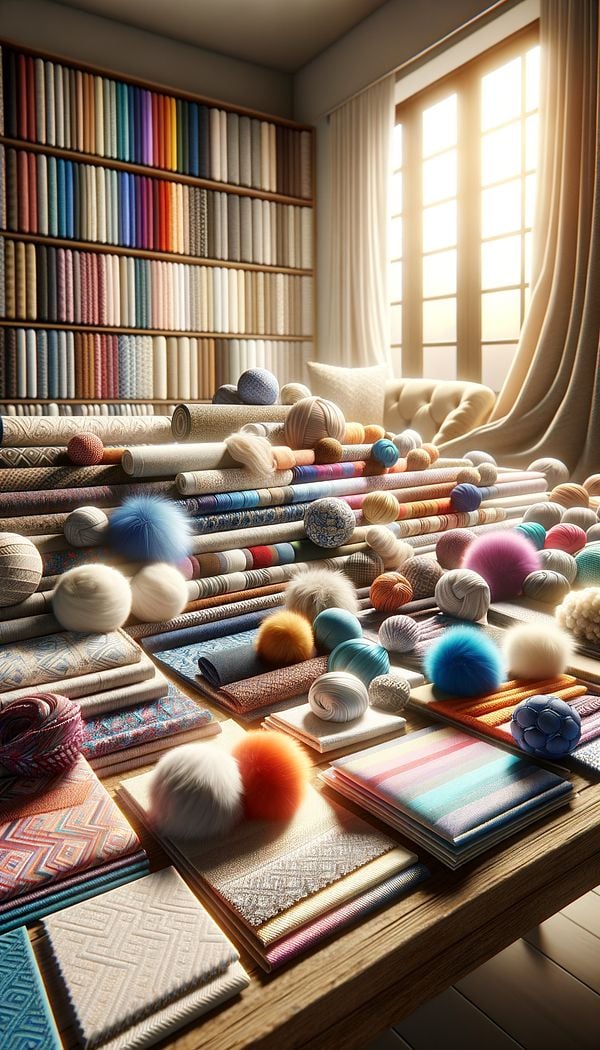What is Textile?
Textile refers to any material made from interlocking fibers.
Description
Textile, in the world of interior design, encompasses a broad category of materials that includes everything from fabric used in clothing to materials used for home furnishings. The term itself refers to any type of material that is made from interlocking fibers, be it natural fibers like cotton, wool, and silk or synthetic fibers such as polyester and nylon. A critical component of interior design, textiles offer both functional and aesthetic properties, serving as the building blocks for creating ambiance, comfort, and style in any space.
The choice of textile can drastically transform a room, influencing both its appearance and atmosphere. From heavy, plush velvet that adds a touch of luxury and warmth, to light, airy linen that brings a sense of openness and relaxation, the selection is vast and varied. Textiles are used in a multitude of ways within interior design, from upholstery and window treatments to rugs and decorative pillows. They play a key role in setting the tone of a room, adding color, texture, and pattern, and contributing to the overall design theme.
Beyond aesthetics, textiles also have practical applications in interior design. They can improve acoustics by absorbing sound, enhance comfort through temperature regulation and soft surfaces, and even offer durability and protection for furniture. Innovations in textile production have also led to the development of sustainable and eco-friendly fabrics, further broadening the scope and application of textiles in interior spaces.
Usage
Textiles are utilized in a variety of interior design contexts such as upholstering furniture, crafting window treatments, creating soft furnishings like throws and cushions, and designing floor coverings including carpets and rugs. They also play a crucial role in adding layers of texture, color, and pattern to a space, helping to establish the desired mood or theme.
FAQs
-
How do textiles contribute to the practicality of a space?
Textiles contribute to the practicality of a space by enhancing comfort through temperature regulation and soft surfaces, improving acoustics by absorbing sound, and offering durability and protection for furniture
-
What types of fibers are used in textiles?
Textiles are made from both natural fibers, such as cotton, wool, and silk, and synthetic fibers, including polyester and nylon.
-
How can choosing the right textile transform a room?
Choosing the right textile can transform a room by influencing its appearance and atmosphere, adding color, texture, and pattern, and contributing to the overall design theme.
-
Are there eco-friendly options available in textiles?
Yes, innovations in textile production have led to the development of sustainable and eco-friendly fabrics, offering more environmentally responsible choices in interior design.
Practical Application
When selecting textiles for an interior design project, consider the function of the space and the desired mood or theme. Vary textures to add depth and interest, and choose materials that are not only aesthetically pleasing but also suit the practical needs of the space. Explore eco-friendly options for a more sustainable design approach.
-
Decorating Principles & Elements330 articles
-
Textile Techniques10 articles
-
Materials & Textiles360 articles
-
Textiles & Upholstery252 articles
-
Sustainability & Eco-Friendly Design69 articles
-
VignetteA vignette in interior design is a carefully curated display of objects that tell a story or evoke a particular mood.
-
BeadboardBeadboard is a type of paneling characterized by a row of narrow wood planks lined vertically, with each plank featuring a rounded bead-like ridge along its edge.
-
QuiltA quilt is a multi-layered textile comprised of a woven cloth top, a layer of batting or wadding, and a woven back, combined using the technique of quilting.
-
SelvageSelvage refers to the tightly woven edge that runs along each side of a piece of fabric.
-
VelvetVelvet is a luxurious fabric known for its soft, dense pile and distinctive sheen.
